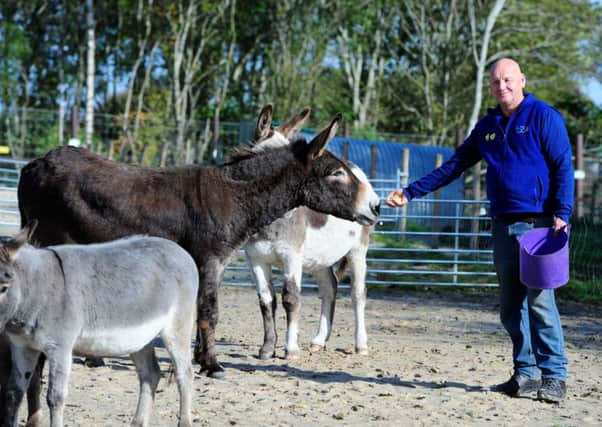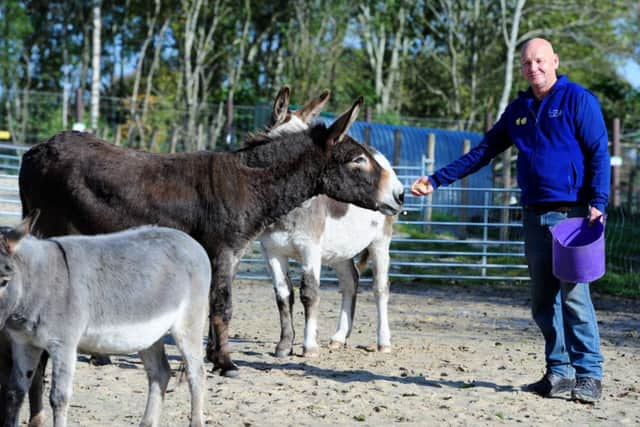How Five Sisters Zoo became accidental sanctuary


Suzy the former circus bear, a giant heaving lump of thick fur and muscle, with curled black razor-sharp claws at the end of paws like shovels, stretches her huge neck towards the sweet treat.
Not that long ago she was so traumatised by life in a tiny cage, beaten and forced to perform and fight for every morsel of food, she’d spin in endless circles, distressed and anxious.
Advertisement
Hide AdAdvertisement
Hide AdInstead now, as Brian coaxes her forward, her nostrils flare with curiosity and suddenly her long pink tongue is happily probing the tips of his fingers, lapping up every trace of the honey’s sweetness.


Next door, her former circus pal Carmen senses what is happening and is waiting patiently for her turn. And Peggy, a little less at ease with these two-legged creatures – perhaps in her wary bear head she recalls the ones who hurt her – might appear disinterested but is almost certainly aware of every movement.
When it comes to her, Brian prefers to deliver the honey via a long blunt implement. “I’m not sure I trust her quite as much as the others,” he concedes. “But who knows what she’s been through.”
It’s a moment of trust and tenderness between the owner of the Five Sisters Zoo and the trio of rescued circus bears, a sign that whatever hardship and heartache it’s taken him and wife Shirley to build this remarkable sanctuary – and there has been an awful lot – it’s been worthwhile.
The Romanian bears arrived in 2012, brought from the hell of their grim surroundings to a new home complete with pool, trickling waterfall and sprawling grounds to roam in. For three animals which had spent 20 years being transported around Europe in cages barely bigger than their own bodies, their home in the shadow of West Lothian’s Five Sisters bings must seem like paradise.
Their arrival was made possible largely thanks to public donations and overwhelming support. And for Brian, 54, and Shirley, 50, it was something of a definitive moment. For tending to three traumatised bears presented one of the biggest and most complex challenges they had faced since the days they stumbled almost accidentally into their lives as zoo owners.
Now bolstered by that success, and almost unable to turn down any animal they believe they might be able to help, they are preparing to embark on an even bigger test.
The zoo, which began life as a garden centre with a couple of fluffy bunnies to keep kids entertained while their parents shopped, has just announced a £150,000 appeal to help save four male lions, rescued from a travelling zoo and facing an uncertain future.
Advertisement
Hide AdAdvertisement
Hide AdLaunched just days ago, the bid to bring them from the temporary sanctuary where they have stayed since being seized by Belgian authorities in May has already topped the £8000 mark. Donations are coming in, a tenner here, £20 there, slowly and surely.
There’s just six months to raise the cash and Brian already has a spot in mind for their new enclosure. By chance, it’s on land that was once a shale bing, where as a child growing up just a few hundred yards away, Brian would wander around looking out for newts, frogs and tadpoles and bringing any injured creatures he found home to his rather exasperated mum.
“I was always out here looking for wildlife,” he nods, surveying the enclosure. “I’d take home lots of tadpoles and release them as frogs. I brought an injured jackdaw home once but my mum wasn’t too keen on that.
“It was a great place to grow up, friendly with community spirit.”
That community spirit has shone through for the Currans time and again, helping them grow and develop what had started as a tiny collection of small pets into a BIAZA (British and Irish Association of Zoos and Aquarium) accredited establishment and in 2012 one of the top 20 paid-for visitor attractions in Scotland.
It’s one of the fastest growing establishments of its kind in the UK, yet it was never the couple’s intention to become zoo bosses.
“We have to pinch ourselves every now and again,” admits Brian. “We never set out to have a zoo. It just happened.
“We had a garden centre but it never really got going, we worked hard but we struggled. At the same time we had animals at the back door and we wanted a small holding to keep some more – Shirley is passionate about animals, we both are.
Advertisement
Hide AdAdvertisement
Hide Ad“People would come to us with a rabbit to rehome, anything from a hedgehog to a fox which was found injured at the side of the road. His face was deformed, we took him in and called him Basil.”
They gradually built up their collection of animals, some from other zoos where they were excess to requirements, even facing euthanasia, others from private collectors who couldn’t cope with their growing pet. It means every animal on show has its own story, many would not be alive today if not for the Currans.
There’s Stumpy the geriatric ring tailed lemur who came from Edinburgh Zoo and is an impressive 28 years old; animals from Gorgie City Farm which staff wanted to ensure lived a long, happy life; wallabies and an emu that were rescued from a sanctuary in Fife embroiled in welfare allegations; and a dozen giant African spurred tortoises, still just babies, which were brought to West Lothian after customs officers found them being smuggled from Africa.
Brian says a lot is down to loyal supporters who have helped keep the zoo afloat with cash, sponsorship and offers of help. Their help was never needed more than at Easter last year, when a brilliant holiday weekend went up in smoke.
The couple, who live next door to the zoo’s entrance, were woken in the early hours of the morning to a scene from hell.
“It was one of the worst days of my life,” says Brian.
Fire killed hundreds of creatures. Brian and his sons tried to save as many as they could, but the flames and the smoke were fierce and the challenge too great.
“Within hours people were phoning up, coming in with supplies and donations. I get embarrassed. I don’t like to ask for money, but people were desperate to help and we couldn’t say no.”
Thousands of pounds poured in. It’s been put to effective use – today the zoo is preparing for the December opening of the new reptile house alongside the new medieval castle-themed enclosure which has black rats creeping over a kitchen setting and bats hanging from the roof. Children, apparently, love it.
Advertisement
Hide AdAdvertisement
Hide AdSoon there’ll be four new ferocious beasts to get to know. The four lions currently held in Belgium faced an uncertain future. Soon, however, the wild plains of Polbeth bing could be their home.
“This is a perfect location for them,” he adds, looking towards the land he played on as a lad. “Caring for them won’t be easy – they are damaged by what has happened to them – but we have to do our best.”
• For more, go to www.fivesisterszoo.co.uk. To help the lion fund, send a cheque payable to Circus Lion Rescue Fund or via BACS: Royal Bank of Scotland, sort code: 83 28 03, account: 00266061.
Rebuilding after tragedy
FIVE Sisters Zoo stretches over a 20-acre site on the outskirts of Polbeth in West Lothian.
It employs 17 staff. Owners Brian and Shirley Curran’s three sons, Brian, Gary and Graeme, all help out at the zoo.
It opened in 2005 and now has more than 100 different species of mammals, birds and reptiles.
In 2012, it had around 97,000 visitors. Fire in 2013, however, devastated parts of the zoo and killed hundreds of small creatures, including 11 meerkats and the zoo’s male otter. Two crocodiles which were adopted from Edinburgh Zoo survived the blaze.
A huge outpouring of support raised £110,000 to help the zoo rebuild following the tragedy.
Two surviving meerkats were nursed back to health and have since produced four babies.